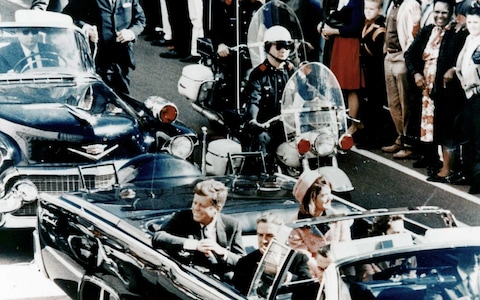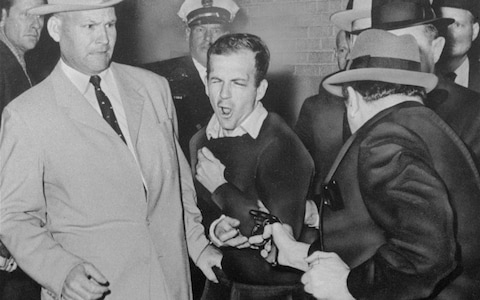Will we ever see the last of the JFK files… and what do they contain?
On November 22 1963, just an hour or two after the fatal shooting of President John F. Kennedy on a sunny Friday afternoon in Dallas, television commentators began to point blame for the president’s murder at a cabal of right-wingers in the Texan city. Supposedly, they were outraged by Kennedy’s liberal social policies. First Lady Jacqui Kennedy was still standing aboard Air Force One at the time, next to her husband’s devastated body, her dress still spattered with blood.
That theory turned out to be unfounded. But it marked only the beginnings of what is now a vast, complex web of claims and counterclaims about the president’s murder. Some have devoted their careers to uncovering the “truth”; government officials, Hollywood producers, and internet sleuths have all had their say. Arguments about the Kennedy assassination are sometimes described as the “mother of all” conspiracy theories.
Some think Kennedy was whacked by the mafia as revenge for his campaign against organised crime; others suggest he was the victim of a plot orchestrated by his own Central Intelligence Agency (CIA); others blame the Soviet Union. None of these theories has ever been proven. And there are others, of course, who argue that the official explanation is probably the correct one: that Kennedy was killed by Lee Harvey Oswald, a 24-year-old former US marine and Communist sympathiser, who acted alone when he shot Kennedy twice with a sniper rifle from the sixth floor of the Texas School Book Depository. While trying to escape, he also murdered police officer J.D. Tippit.
This week, Kennedy enthusiasts hoped they might finally get their answer. Tuesday was the deadline by which the US federal government was supposed to release its final classified documents on the JFK assassination. Whilst the likelihood of a “smoking gun” looked slim, Kennedy experts hoped the files might shed some light on the circumstances leading up to the president’s murder in Dealey Plaza, as well as the government’s poorly-handled investigation into it afterwards.
It wasn’t to be. On Friday, President Biden decided the files should remain withheld from the public until at least December 2022. The White House blamed the delay on administrative difficulties created by Covid-19, which, officials said, had a “significant impact on the agencies” that need to be consulted.
The decision has left Kennedy experts feeling frustrated. Some say they are now more curious than ever to see what, exactly, is inside the files. “That’s more than disappointing, it’s a bit of an insult,” says former Washington Post journalist and author Jefferson Morley, who has devoted much of his career to JFK, writing several books; he even fought a 16-year lawsuit against the CIA in an attempt to see more files. “Does the law mean anything?”
The murder of the president as he sat in the backseat of an open-top limousine inflicted a deep blow to the American psyche. Within weeks, claims of a dark, sinister plot were widespread in American homes and workplaces. Perceptions of a cover-up were fuelled two days after the assassination, when Oswald was shot dead by a nightclub owner as he was escorted out of Dallas Police Headquarters. There is only one video of Kennedy’s murder, filmed on a home movie camera by Dallas shopkeeper Abraham Zapruder, who sold the video to the media for $50,000. Within days of the murder, that 26-second clip was already being played and re-played on American television and, in later decades with the advent of higher-tech video analysis, each of the video’s frames was pulled apart and examined forensically for clues.

Experts hoped the files might shed some light on the circumstances leading up to the JFK’s assassination
Credit: Universal History Archive/Universal Images Group via Getty Images
The issue reared its head again in 1979, when the US Congress’s Committee on Assassinations ruled that previous investigations into Kennedy’s death had done a shoddy job. It is “likely” that Kennedy was killed as part of a conspiracy and that two shooters fired on the presidential limousine, their report claimed.
But it was in 1992, in the wake of Oliver Stone’s Hollywood hit film, JFK, which depicts a sinister government plot to kill the president (liberally mixing fact with fiction), that Congress decided to pass a law forcing the US federal agencies to release every file they had pertaining to the JFK assassination. At the time, there were thought to be some 319,000 such files at the US National Archive in Washington. The 1992 bill was passed unanimously (a rare feat in US politics), with support from the then Senator for Delaware, Joe Biden. It gave the government a 25-year deadline, meaning all files had to be made public by 2017.
At first, government agencies obliged, releasing thousands of files over the following decades. Some proved surprising. It was revealed, for example, that Oswald was already a known quantity to the CIA well before he shot Kennedy. In the weeks after Kennedy’s murder, the CIA claimed they could only find about six documents on Oswald from before the assassination (collected as part of their widespread monitoring of Soviet sympathisers), Morley says, but the new release showed they actually had more like 42 documents on Oswald – including one signed off by Jim Hood, the CIA’s chief of operations in the western hemisphere.
The files also revealed the existence of a CIA proposal to provoke a war with Cuba.
But progress soon stalled. With Congress’s 2017 deadline fast approaching, thousands of files remained under wraps. President Trump, who was elected as an anti-establishment maverick who would drain Washington “swamp”, initially sounded bullish about releasing the rest of the files. Indeed, Trump was himself partial to a Kennedy conspiracy theory, having in 2016 made the bizarre, unfounded claim that the father of his Republican rival, Ted Cruz, was somehow implicated in Kennedy’s death.
In 2017, Trump did indeed allow the release of some 19,000 files – but he surprised his anti-establishment supporters by deciding to hold back some files, and leave redactions on others, citing national security concerns. The White House delayed the release by four years; now, Biden has kicked the can down the road ever further, to December 2022. Some scholars are starting to wonder whether we will ever see the files.

Lee Harvey Oswald’s death at the hands of a night club owner only fuelled the conspiracy theories
Credit: AP/ Dallas Times-Herald, Bob Jackson
Judging from redacted sections in already-published files, it’s thought that the secret files would shed more light on Oswald’s mysterious trip to Mexico City in September 1963, two months before he shot Kennedy, where he visited the Cuban and Soviet embassies trying to obtain a Soviet visa. As a student, Oswald had volunteered with a pro-Cuba group; later, in his early 20s, he spent time in the Soviet Union. Investigators think Oswald saw himself as something of a heroic loner; in his apartment, police found a copy of J.D. Salinger’s The Catcher in the Rye.
We already know the Mexico City trip took place, but the new files might shed more light on Oswald’s Communist links. Some assassination sleuths have long argued that Oswald was hired by the Soviet Union in a Cold War hit – though this has never been proven. New details on the Mexico City trip will also tell us more about the “nature of the [CIA] operations that detected him”, says Morley, further clarifying the extent to which the CIA was aware of Oswald before the assassination. “[The files] all speak to this question of ‘Was Oswald manipulated?’. They [the CIA] knew so much more about him than they ever conceded,” he says.
The classified files are also thought to contain details about the CIA’s secret plot to assassinate Cuban president Fidel Castro. Some have long argued that the Cuban government might have hired Oswald to kill Kennedy as a revenge mission, after catching wind of this plot from their spies – though this has never been proven.
It all sounds enticing, but scholars think it’s unlikely that we’ll see the new JFK files any time soon. Morley thinks Biden is afraid of upsetting his intelligence agencies, especially due to what he describes as the looming threat posed by Donald Trump’s authoritarian movement. “Biden needs the CIA right now. He faces this unprecedented threat from an obviously authoritarian movement that is intent on taking power illegally if necessary. He needs his security forces; he’s not going to do anything to alienate them.”
*** This article has been archived for your research. The original version from Telegraph.co.uk can be found here ***


